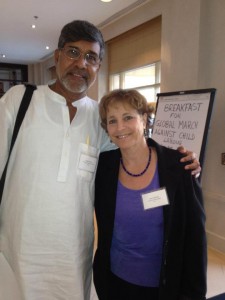A 14-Year-Old Mulls “The Price of Freedom” and Decides to Engage in the Battle to End Child Labor
By Nikeeta Singh
Nikeeta Singh is a 14-year-old student in New Delhi, India.
It is said that childhood is the best gift given to us by God. Everything is different when you’re a child: the trees are higher, the colours are more vivid than ever, and every new day is a new opportunity.
However, childhood is not the same for all. For some it is waking up at six in the morning and working till the sun sets; it is staying away from your parents to earn minimum wages; it is working in inhumane environments in hopes of a brighter future. This is the reality of child labour.

Nikeeta Singh
Child labour is experienced by every one in ten children around the globe. At the age when children should worry about their marks they are worrying about their health and economic status. But how can we blame these innocent angels? Uneducated parents are one of the major sources that contribute to child labour. It is the children of poor and marginalized communities who are often trafficked and forced into labour. Parents of these children are either betrayed or lured into schemes due to their lack of awareness and poor socio-economic conditions, forcing them to send or sell their children for better livelihood options. Traffickers promise daily wages to parents of young children and transport them to big cities where they are often treated as commodities. Families in dire financial conditions are can be approached by traffickers with an offer to buy their children, and with no other escape from their pitiful conditions, parents comply.
One of the major effects of child labour on children is losing access to education. Every day, some 218 million children around the world go to work instead of school—152 million are trapped in child labour (work which harms their development). Education is the route out of poverty for many children. It gives them a chance to gain the knowledge and skills needed to improve their lives; however, many a times their education is treated as a luxury, not a necessity.
In India, there is a great need for convergence and implementation of comprehensive child protection mechanisms. Indian children are exposed to multiple vulnerabilities. With thousands of children still working in brick kilns, construction sites, and agricultural land, trafficking for the sake of forced child labour is widely prevalent. Apart from this, horrific stories emerge daily of girls as young as 9 years old being forced into the sex trade. Apart from this, children are also sold by their parents to work in factories and industries in toxic environments that are highly dangerous.
“If a child is denied education and forced to work instead, violence has been inflicted,” noted Nobel Peace Prize laureate Kailash Satyarthi. “If a child and its parents are denied opportunities for a promising tomorrow, violence has been inflicted. If a child reels under poverty, violence has been inflicted. If obstacles are laid in the path of a child, inhibiting her progress and development, violence has been inflicted.”
As evil of a sin child labour is, there have been many improvements. Organisations such as Child Rights and You (CRY), CHILDLINE India Foundation, Kailash Satyarthi Children’s Foundation, the International Labour Organisation and numerous others have taken up the initiative to ensure that every child in the world is free, safe, healthy, receives quality education, and has the opportunity to realise their potential.
Today, as we speak 100 million children have fallen prey to child labour. The current COVID-19 pandemic can potentially increase the number and further aggravate the problem in regions where child labour has been more resistant to policy and programme measures. The level of global economic integration and the current crisis are likely to have a large and possibly lasting worldwide adverse socio-economic and financial impact.






